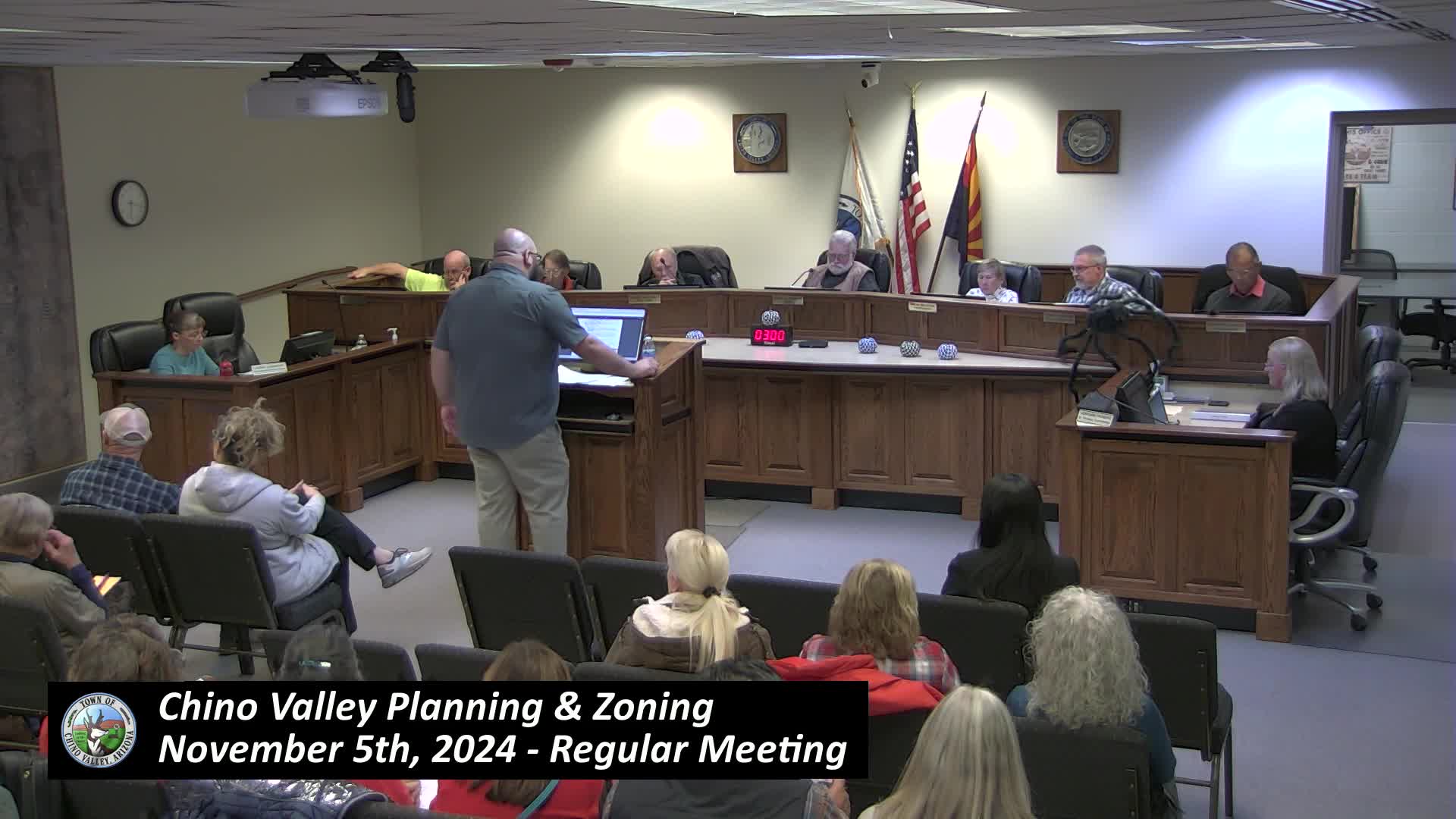Chino Valley solar project guidelines mandate wildlife protection and public safety measures
November 06, 2024 | Chino Valley, Yavapai County, Arizona
This article was created by AI summarizing key points discussed. AI makes mistakes, so for full details and context, please refer to the video of the full meeting. Please report any errors so we can fix them. Report an error »

In a recent meeting held on November 5, 2024, the Chino Valley Planning and Zoning Commission discussed critical regulations for utility-scale solar projects in the area. The meeting highlighted the need for careful planning to balance development with environmental protection and community safety.
One of the primary topics was the grading of sites for solar installations. The committee recommended that no more than 20% of any site be mass graded to preserve natural land features. Additionally, areas with slopes greater than 5% cannot be graded, which also restricts the placement of solar panels in these regions. This decision aims to maintain the integrity of the landscape and prevent potential ecological disruption.
Wildlife protection emerged as another significant concern. The commission emphasized the necessity for developers to create a wildlife protection plan approved by the Arizona Game and Fish Department. This requirement stems from discussions about ensuring compatibility between solar facilities and local wildlife, particularly regarding the preservation of wildlife corridors. The commission is keen on using wildlife-friendly fencing and ensuring that solar projects do not interfere with the habitats of species such as pronghorn.
Public safety was also a focal point of the meeting. Many proposed solar project sites are outside established fire districts, prompting the requirement for developers to annex into the Central Arizona Fire and Medical Authority (CAFMA). This annexation will ensure that fire mitigation plans are in place, particularly concerning battery energy storage systems, which must be regularly updated to incorporate the latest fire suppression techniques.
Traffic impact was another critical issue discussed. Developers are required to conduct a traffic impact analysis to evaluate the effects of construction and operation on local roads. They must also provide a road improvement plan to maintain access to existing forest service roads, which are vital for both the community and the region.
The commission addressed visual impacts as well, mandating that utility buildings and equipment storage areas be screened with a minimum 7-foot high concrete masonry wall. Developers must conduct a view shed analysis to determine appropriate screening measures, especially in proximity to residential areas.
Lastly, the meeting touched on glare and safety concerns related to solar panels. The commission noted that newer solar panels have significantly lower reflective values compared to older models, which had caused complaints in the past. All solar equipment must now adhere to strict guidelines to minimize glare, including considerations for the supports of the panels.
Overall, the discussions at the Chino Valley Planning and Zoning Commission meeting reflect a comprehensive approach to managing the growth of solar energy projects while safeguarding the environment and community interests. As these regulations are implemented, they will play a crucial role in shaping the future of solar energy development in Chino Valley.
One of the primary topics was the grading of sites for solar installations. The committee recommended that no more than 20% of any site be mass graded to preserve natural land features. Additionally, areas with slopes greater than 5% cannot be graded, which also restricts the placement of solar panels in these regions. This decision aims to maintain the integrity of the landscape and prevent potential ecological disruption.
Wildlife protection emerged as another significant concern. The commission emphasized the necessity for developers to create a wildlife protection plan approved by the Arizona Game and Fish Department. This requirement stems from discussions about ensuring compatibility between solar facilities and local wildlife, particularly regarding the preservation of wildlife corridors. The commission is keen on using wildlife-friendly fencing and ensuring that solar projects do not interfere with the habitats of species such as pronghorn.
Public safety was also a focal point of the meeting. Many proposed solar project sites are outside established fire districts, prompting the requirement for developers to annex into the Central Arizona Fire and Medical Authority (CAFMA). This annexation will ensure that fire mitigation plans are in place, particularly concerning battery energy storage systems, which must be regularly updated to incorporate the latest fire suppression techniques.
Traffic impact was another critical issue discussed. Developers are required to conduct a traffic impact analysis to evaluate the effects of construction and operation on local roads. They must also provide a road improvement plan to maintain access to existing forest service roads, which are vital for both the community and the region.
The commission addressed visual impacts as well, mandating that utility buildings and equipment storage areas be screened with a minimum 7-foot high concrete masonry wall. Developers must conduct a view shed analysis to determine appropriate screening measures, especially in proximity to residential areas.
Lastly, the meeting touched on glare and safety concerns related to solar panels. The commission noted that newer solar panels have significantly lower reflective values compared to older models, which had caused complaints in the past. All solar equipment must now adhere to strict guidelines to minimize glare, including considerations for the supports of the panels.
Overall, the discussions at the Chino Valley Planning and Zoning Commission meeting reflect a comprehensive approach to managing the growth of solar energy projects while safeguarding the environment and community interests. As these regulations are implemented, they will play a crucial role in shaping the future of solar energy development in Chino Valley.
View full meeting
This article is based on a recent meeting—watch the full video and explore the complete transcript for deeper insights into the discussion.
View full meeting
